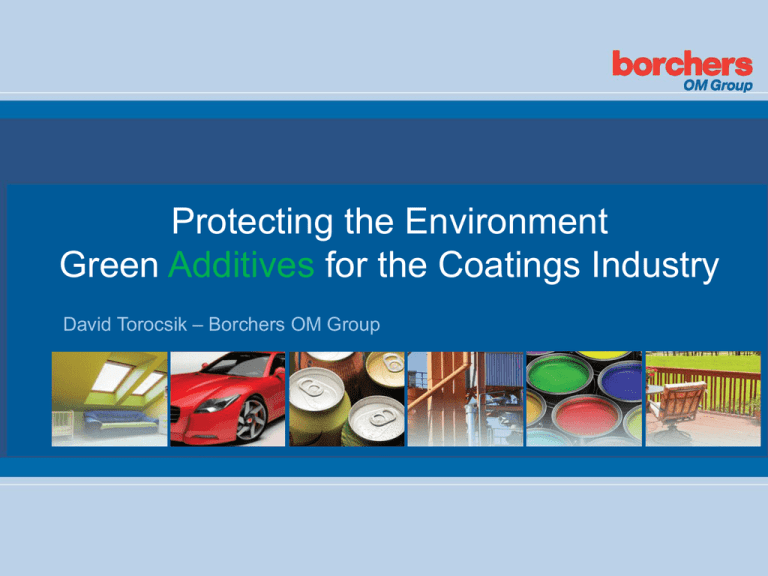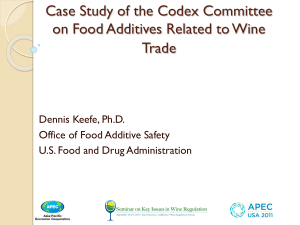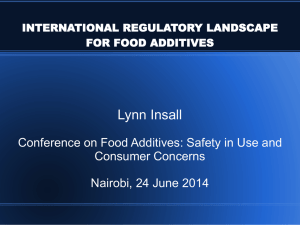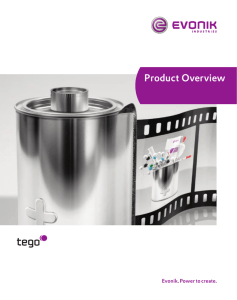green additives for the coatings industry
advertisement

Protecting the Environment Green Additives for the Coatings Industry David Torocsik – Borchers OM Group Content Environment in the 21st century reasons for being Green Definitions of Being Green “Green” Solutions to Being Environmentally Friendly Raw Materials from Nature as Building Blocks Environmentally Friendly Alternatives to Hazardous Chemicals Conclusion 2 Environment in the 21st Century- Good Reason for Being Green Europian heat wave 2003 Pakistan floods 2010 Katrina 2005 Pictures source: Wikipedia 3 Several Definitions of “Green” Products Low or No VOC’s Bio-based AND Non-hazardous The product contains a high percentage of bio-based components either as supplied, or 100% of the active substance is bio-based 4 How to Become More Environmentally Friendly? Use more Renewable or Sustainable Non-Hazardous raw materials Reduce VOC Content by making Higher Solids formulations Convert our Solventborne formulations to Waterborne with Equivalent Properties Product Stewardship – Cradle to Grave Awareness Recycle and Rework Paint Waste whenever possible 5 Use More Raw Materials from Nature as Potential Building Blocks Vegetable Oils – Triglycerides O O O O O O Glycerol-Based Alkyds O O O R= O Chain of linoleic acid n O R O Chain of a-linolenic acid 6 Use More Raw Materials from Nature as Potential Building Blocks Fatty acids can be a source for metal soaps and alkyd binders OH Stearinic acid O OH -Linolenic acid O Alcohols can be used to make non-ionic surfactants and PU compounds OH OH Stearyl alcohol Lauryl alcohol O O O O OH Ethoxylated cetyl alcohol 7 Use More Raw Materials from Nature as Potential Building Blocks Polyols: glycerol and sugar derivatives H2C OH HC OH H2C OH HOOC O HC OH H2C OH (Poly)ester Reaction with OCN O H2C R C R HO (Poly)urethane OH O C17H35 Glycerol monostearate APG – Alkyl Polyglycosides (biodegradable surfactants) O O C17H33 OH Sorbitan monooleate OH H O O HO OH n O CH2 CH3 m 8 Use More Raw Materials from Nature as Potential Building Blocks Epoxy Hardeners from Cashew Nutshell Liquid (CNSL) Anacardic acid C15:3 OH Cardanol O Phenalkamine OH OH OH H2N R (CH2)n R NH R R= Acrylic Compounds O O O O Furfuryl acrylate O C 18 H 37 Stearyl methacrylate 9 What are Environmentally Friendly Additives? Additives that help make High Solids, Bio-Based or Waterborne Binder alternatives possible What options are available? Cobalt Free Driers Additives that contribute Zero VOC’s Tin Free Catalysts Additives Containing Sustainable Raw Materials Additives with Universal Applications – Waterborne, Solventborne and Solvent Free Coatings that result in fewer Specialized Additives 10 History of Bio-Renewable Systems The original bio-renewable binder systems were based on natural and synthetic oils (alkyds). However, they had two major flaws that were driving them to extinction: 1. They needed to be dissolved in petroleum based solvents that contain (VOC’s) 2. Also that they needed hazardous metal based catalysts to accelerate crosslinking Over time Alkyd binders have been developed that are soluble in water or exempt solvents. However, most still rely on metal based driers, which then face us with an even tougher challenge of “how replace metal catalysts considered to be hazardous?” 11 Cobalt Driers – Regulatory Concerns Cobalt has been the metal drier of choice for binders that cure via oxidation for over 100 years. However, Cobalt carboxylates are on the verge of being labeled more hazardous in Europe which will eventually affect all countries that sell products to Europe making it a global concern Cobalt carboxylates promote surface dry in coatings and without these surface driers – bio-based binders that cure via oxidation will not dry properly 12 Labeling of Cobalt-Carboxylates Current Labeling Cobalt-bis(2-ethylhexanoate), Cobalt 2 neodecanoate, Cobalt naphthenate CAS Nr. 136-52-7, EINECS Nr. 205-250-6 DSD: Repr. Cat. 3; R62 - Possible risk of impaired fertility Xn; R65 - lung damage if swallowed R43 - May cause sensitization by skin contact N; R50/53 - Very toxic to aquatic organisms, may cause long-term adverse effects in the aquatic environment R66 – Repeated exposure may cause skin dryness or cracking CLP: Repr. 2; H361f, Skin sens. 1; H317, Eye Irrit. 2; H319, Aquatic Acute 1; H400, Aquatic Chronic 1; H410 13 What are some Cobalt Drier Alternatives? Manganese driers by itself used in waterborne and solvent-borne alkyd systems Accelerated Manganese driers Also available are Iron-based complex compounds that work well in waterborne and solventborne alkyd systems, and some contain Zero VOC’s 14 Performance Advantages Involving Cobalt Alternatives Co Co replacement #1 Co replacement #2 10°C – 80RH 10°C – 30RH 23°C – 55RH (standard conditions) 0 0 2 4 2 4 6 6 8 8 10 10 12 12 14 Improved dry in cool damp conditions and less yellowing over time Lightness (L value) Tack Free Dry Time (in hours) 82 80 78 76 74 72 70 68 66 64 62 dark light Lightness (L value) after 2 months of storage in the dark and in the light without drier 0.079% Co Co, Zr drier Cobalt Free 0.00065% Fe Driers new catalyst 15 Why Use Anti-Skinning Additives? Coatings that cure via oxidation require additives to prevent skinning in the can during storage The most common anti-skinning additive for Cobalt containing systems is the volatile complexing agent methyl ethyl ketoxime (MEKO) What are some of the issues with MEKO? Its toxicity and corresponding labeling issues It doesn’t always work well with a number of cobalt replacement driers 16 Anti-Skinning Additives that are possible replacements for MEKO Phenolic based anti-skinning additives Product Issues: slow evaporation the radical absorber stays in the film and may cause yellowing Other slow evaporating Anti-Skinning additives are aminic compounds dissolved in Fatty acid esters or glycolic solvents Advantages: Works for all metal types Reduced toxicity Disadvantages: Dosage has to be experimentally determined to avoid excessive amounts causing prolonged drying time 17 Catalysts in Polyurethane Based Coatings and Additives + R-N=C=O + R`-OH catalyst H O R-N-C-O-R´ MLn - polyisocyanate polyol polyurethane Function to increase chemical reactivity of polyurethane systems Polyurethanes are used in highly durable coatings, gel coats and other additives like rheology modifiers and dispersants 18 Catalyst Options Types Used in Coatings Catalysts alkylated tin compounds (e.g. Dibutyltin dilaurate) metal carboxylates (e.g. Bismuth or Lithium) tertiary amines Mechanism Application Lewis-acid-mechanism polarization of isocyanate improves electrophilic properties of carbonyl group 1K & 2K polyurethanes blocked isocyanates Lewis-acid-mechanism polarization of isocyanate improves electrophilic properties of carbonyl group Insertion mechanism after formation of alcoholate 1K & 2K polyurethanes blocked isocyanates Lewis-base-mechanism increase nucleophilic properties of OH compound 2K polyurethanes epoxy resins 19 Tin Catalysts: Hazardous Chemical for the Production of Polyurethane Coatings and a Conflict Mineral HMIS rating: DBTL on the ECHA (European Chemicals Agency Reach) website has been registered with a GHS 1B reproductive toxicity classification as well as STOT (Specific Target Organ Toxicity) – single and STOT – Repeated Class 1 which could lead to a 3* HMIS rating as they are both chronic endpoints The Dodd-Frank Act targets the sources of Cassiterite/Tin. There are many unrestricted sources of Tin available but proving the source of Tin is a continuous concern 20 PU Catalysts: Tin Based Compared to Bismuth Based on the Organic Components the OH-NCO reaction: influence on catalystBismuth The Effect of different carboxylates on OH-NCO reaction: N 3300); (D'dur Isocyanurate / 870) A (D'phen [OH-Acrylic OH-Acrylic (Desmophen A 870) / Isocyanurate ( Desmodur N 3300) concentration: 0.003% metal / binder] [catalyst concentration: 0.003% metal / solid binder] 0,14 NCO-absorption 0,12 0,1 0,08 0,06 0,04 0,02 0 0:00 2:24 DBTL Acid Blend Kat 24 Borchi 4:48 Neodecanoate 315 catalyst 7:12 Octoate 320 catalyst 9:36 Other322 catalyst 12:00 14:24 time [h] 21 Bismuth Catalysts - Extending Pot Life pot-Life of different catalyzed clear coats based on Desmophen A VP LS 2383 60 viscosity [s] 50 40 30 20 10 0 0h DBTL 1h 2h Octoate Borchi Kat 24 3h 4h Neodecanoate Borchi Kat 0243 5h 6h 7h time [h] 22 The Smart Choice - Dispersants Based on Sustainable Raw Materials Branched polyurethane oligomer For waterborne systems Contains sugar, fatty alcohol and acid More than 50% sustainable RM 90% active in water 23 Dispersants Based on Sustainable Raw Materials (SRM) SRM Dispersant Conventional Conventional SRM Dispersant 24 Dispersants Based on Sustainable Raw Materials SRM Dispersant Conventional Conventional SRM Dispersant 25 Summary The coatings industry uses huge amounts of raw materials and is facing the challenge to switch to renewable resources Recent alternative additives support the continued use of biorenewable resin systems where only hazardous materials were effective before Many sustainable raw materials are already available New “green” additives can generate equal or better properties to current hazardous agents Cost effective alternative formulations are possible 26 Thank you for your attention Questions? OMG Americas, Inc. 811 Sharon Drive Westlake, Ohio 44145-1522 USA 440-889-2950 880-321-9696 eMail: Cust.service@na.omgi.com www.borchers.com www.omgi.com 27





